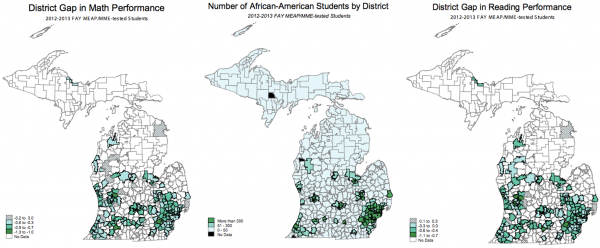Equal Access to Education for All: A Civil Rights Issue
COURTESY OF MICHIGAN DEPARTMENT OF EDUCATION
Depicted: number of black students in each Michigan school district compared to the respective achievement gap in reading and math performance, measured in Grade Equivalent Units. Zero represents the national average, so a negative numeric value indicates how many grade levels below the mean students in the district are performing.
September 11, 2018
Imagine this: You walk into your school and are immediately engulfed in temperatures exceeding 90 degrees due to defective furnaces. As you proceed to walk down the hall, metal detectors welcome you, making you question whether you are a student or a miscreant. The water is irrefutably undrinkable. There are insects crawling around the cafeteria. Pieces of classroom ceilings periodically break and fall. The population of the school is composed of academically neglected students, faculty that is either apathetic or unqualified, and vermin roaming the halls. You are legally obligated to sit through classes for hours at a time, but you still can’t decode the symbols of the alphabet strung together on the board and translate them into words. Your potential is imprisoned by the education system, locked behind skills that should be second nature by now.
What if you found out that the only thing holding you back from achieving your greatest level of success was the color of your skin? Would you fight for justice?
Some have. Seven students took it upon themselves to file a class action lawsuit against the state of Michigan for denying minorities in Detroit access to literacy. Usually, cases about education are reviewed by state courts. But since the students believed their inability to obtain a quality education transgressed their constitutional rights, this case, Gary B. v. Snyder, was assessed by a U.S. district judge.
The decision for the suit could have produced a notable court precedent and acted as a potent weapon against poverty, injustice and de facto discrimination. Instead, the ruling was a huge disappointment for those opposed to systemic injustice. Judge Stephen Murphy III determined that even though literacy is intrinsic to the well-being of an individual, the Constitution does not stipulate the attainment of literacy as fundamental to one’s life, liberty and the pursuit of happiness.
Imagine that.
It is true that access to a quality education is not explicitly guaranteed in our Constitution. However, the Constitution has not always been interpreted to uphold civil rights. The most noteworthy example is the Plessy v. Ferguson Supreme Court case in 1896. The case stated that individuals of different races were “separate but equal,” acknowledging segregation as a legal governing practice.
In 1954, the Brown v. Board of Education Supreme Court decision overturned this case in a unanimous decision, citing the Equal Protection Clause of the 14th Amendment. The Supreme Court justices determined that segregation of public schools based on one’s race inhibited children of color from acquiring a proper education. The court did not rely on precedent to make this decision; rather, the ruling was based on social science studies which indicated that implicit biases impede the academic growth of students. This ruling essentially deemed equal education opportunities as a right.
Two decades later, news surfaced that Governor William Milliken took action to prolong segregation of the public school system in Michigan. After the NAACP sued the state of Michigan for enforcing a racially divided school system, the district court decided to create a desegregation plan by busing students in Detroit across 53 school districts. Shortly thereafter, the Supreme Court case Milliken v. Bradley ruled in a 5–4 decision that segregation of school districts could continue.
The reemergence of a systemic educational schism prompted individuals to fight against these policies which incessantly held back people of color.
We can see that the ruling of Gary B. v. Snyder failed to acknowledge the embedded racism in the system. The discriminatory public policies of the past disproportionately allocated resources to ensure predominantly white districts were granted more opportunities, competent educators, updated curricula and increased funding. This allowed them to prosperously develop while leaving vulnerable, marginalized communities hopelessly underdeveloped. Because of segregation, people of color were unable to integrate into other school districts and, therefore, were incapable of being exposed to the same education and resources as their white peers. Evidently, not much has changed.
Studies show that students from marginalized backgrounds fall behind their white counterparts by two to three years. By the time they reach fourth grade, approximately 70 percent of black students are unable to meet their expected reading level. Additionally, only 16 percent of students from segregated schools are expected to pass college courses, which undeniably affects their ability to flourish in the workforce.
The inequitable distribution of qualified teachers may be the most devastating impediment for students in underserved districts to receive the level of education they deserve. Black students are twice as likely to be assigned educators who are not trained with up-to-date teaching methods. Research suggests that the quality of educators is inextricably linked to the student’s future success. When assigned equally qualified educators, students from marginalized backgrounds are expected to perform just as well as white students from affluent communities.
All of it begins with that alphabet on the board. Without access to literacy, students cannot acquire the skills they need to obtain a higher education, thrive in the workforce and exercise their democratic rights.
It is time to stop obligating socioeconomically disadvantaged students of color to continually sacrifice the hours between 8 a.m. and 3 p.m. every weekday for no academic gain, and start providing them with an education that will prepare them to succeed. Students in Detroit and all over the country are relegated to institutions that not only fail to protect and educate them but also perpetuate the vicious cycle of social inequality.
If literacy is not guaranteed to each and every American student, what exactly do we expect them to gain from public education? Equal opportunities allow all people to have the same educational foundation from which they can cultivate their own destiny through their own merit regardless of their race, nationality, color, gender, age, religion or disability. It is in the fundamental interest of our society to provide students with the finest education to ensure a prosperous future for our country. We owe it to them. Their lives, liberties and individual pursuits of happiness depend on it.














